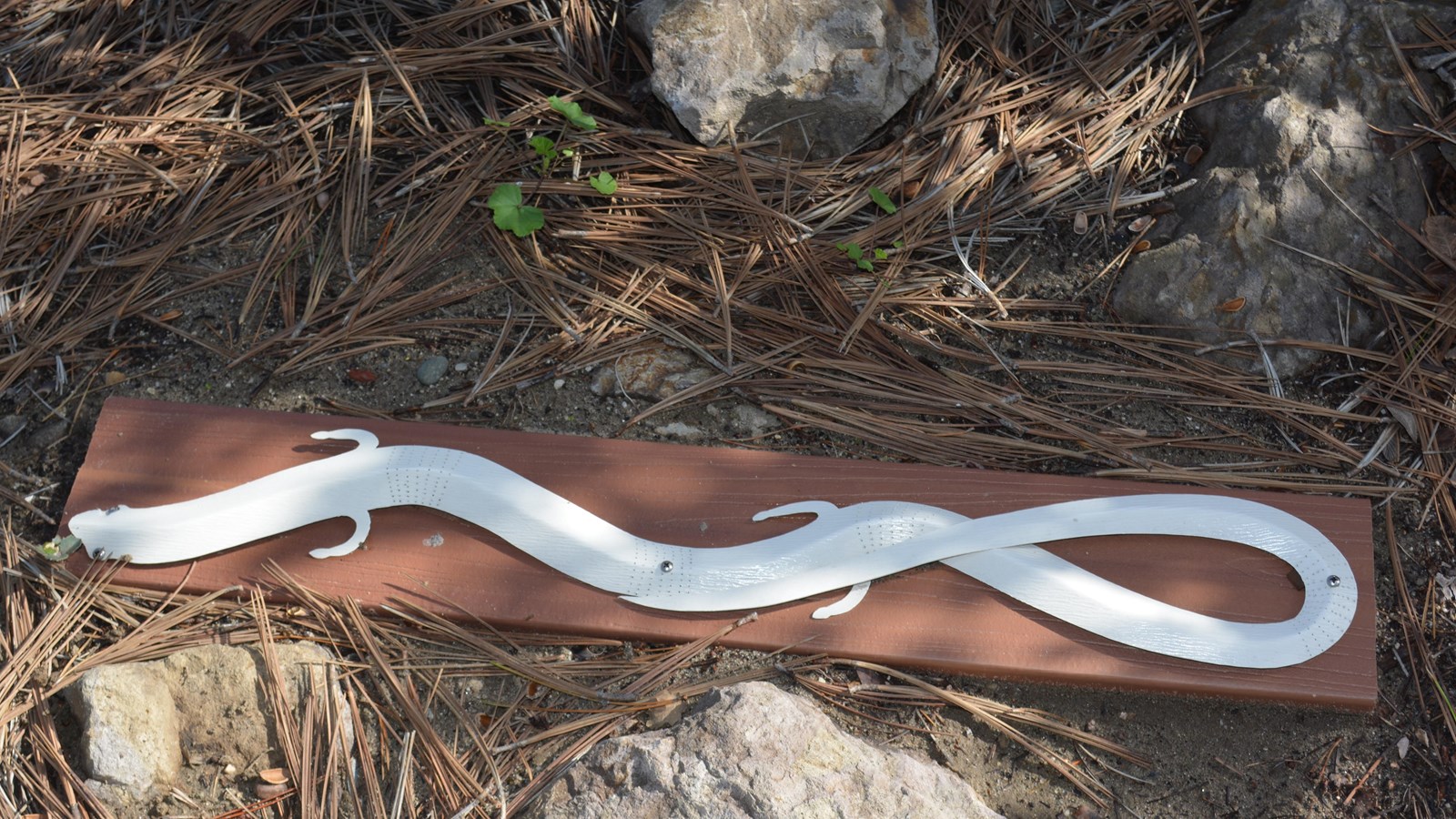Last updated: May 17, 2021
Place
Sculpture: Channel Islands Slender Salamander

Inspired by the unique wildlife of Channel Islands National Park, BiJian Fan's 3D kinetic, PVC sculptures combine science and art to educate and engage visitors to protect the park.
Garden Art
Inspired by the unique wildlife of Channel Islands National Park, BiJian Fan's sculptures combine science and art to educate and engage visitors to protect the park.
BiJian was born in Beijing, China, where he learned paper art from his grandmother. Today, BiJian resides in Camarillo and still creates paper sculptures, but has also expanded to other materials.
In this exhibit, BiJian artistically transformed PVC into 3D kinetic sculptures of a pygmy mammoth, island fox, bald eagle, and other island species.
BiJian's artwork has exhibited internationally and earned numerous recognitions.
Channel Island Slender Salamander Natural History
Scientific Name
Batrachoseps pacificus
Introduction
The Channel Island slender salamander is found on Santa Cruz, San Miguel, Santa Rosa, and Anacapa islands and is the only endemic amphibian found on any of the California islands. This secretive creature is found under rocks and logs (mainly near streams) and also in the soil litter, or duff, during the winter and spring rainy season.
Quick and Cool Facts
- The Channel Islands slender salamander is a member of family Plethodontidae, the lungless salamanders.
- Lungless salamanders breathe through their skin, requiring them to live in damp environments on land, not in water, and to move about on the ground only during times of high humidity.
- Typical of most slender salamanders, when disturbed, this salamander may coil up and remain still, relying on cryptic coloring to avoid detection.
- It might also uncoil quickly and spring away, repeatedly bouncing over the ground, or drop its tail to distract a predator.
- The tail is easily broken off, but it can be regenerated.
- The cool marine climate of the Channel Islands, including summer fog, provides enough moisture for this species to be active all year.
Appearance
The Channel Islands slender salamander is a small slim salamander with 18-20 costal grooves, which denote its rib connections. It has short limbs, a narrow head, long slender body, very long tail, and with its conspicuous costal and end of torso grooves, this species has the worm-like appearance typical of most slender salamanders. There are four toes on the front and hind feet, which is also typical of slender salamanders. Fairly robust for a slender salamander, with relatively long legs. Its coloration is brown to pinkish above with a wide dorsal stripe with indefinite borders, and may be made up of many light speckles. The throat and underside of the tail are pale and the abdomen area is whitish or slate, with light and dark speckling.
Range
The Channel Islands slender salamander is an endemic species found only on the Channel Islands, although not on Santa Barbara Island. Interestingly, Channel Islands slender salamanders share their habitat on Santa Cruz Island with another similar species, the black-bellied slender salamanders without interbreeding. In one February survey, researchers recorded 155 Channel Islands slender salamanders and 152 black-bellied slender salamanders in similar habitat. However, only Channel Islands slender salamanders were found under driftwood on a sandy substrate near the ocean. In general, when only one species is found at a more open site, it is usually Channel Islands slender salamanders.
Habitat
Channel Islands slender salamanders occur in grassland, coastal sage scrub, chaparral, riparian, oak woodlands, and pine forest communities. They have been found under rocks and logs, especially near streams. Dense populations have been found in open areas near the ocean; in February at the west end of Santa Cruz Island, salamanders were abundant under driftwood on sand within 200 feet of the ocean. Periods of surface activity correspond generally to the rainy season, especially in drier inland valleys (e.g., Santa Cruz Island). However, the moderating influence of cool, marine air, combined with daily fog, extends activity throughout the summer.
Feeding
Feeding probably occurs both above and below ground. Studies describe that a similar species, the California slender salamander (B. attenuatus) capture prey using a projectile tongue and feed on small invertebrates, which consist of on earthworms, small slugs, a variety of terrestrial arthropods including sowbugs and millipedes, and insects including collembolans, aphids, caterpillars, small beetles, beetle larvae, and ants. The Channel Islands slender salamander probably eats a similar array of prey items.
Reproduction
The Channel Islands slender salamander do not have the ability to dig their own burrows, but use excavations of other animals and cracks in the soil, in addition to man made tunnels and crevices. Because of this they must descend from the surface to moist areas underground before the late spring. Eggs are laid while the female is below ground during late fall and winter. Egg sets have been found from December 8 to January 18. The number of eggs per set ranged from 13 to 20. Hatchlings emerge during winter and early spring. It is not known if adults tend their young, and the adults and the young animals migrate to the surface during the early rains in the fall and winter. The timing of this cycle is highly dependent on weather, and varies greatly between wet and dry years.
Conservation Status
The most recent edition of the IUCN Red List of Threatened Species listed the Channel Islands slender salamander as of Least Concern since, although its Extent of Occurrence is much less than 5,000 per square kilometer, it is common and occurs in an area of extensive, suitable habitat which appears not to be under threat, it has a presumed large population, and it is unlikely to be declining fast enough to qualify for listing in a more threatened category.
Additional Information
- Natural History of The Islands of California, Schoenherr, Feldmeth & Emerson
- http://www.californiaherps.com/index.html
- http://www.amphibiaweb.org
- http://www.iucnredlist.org/apps/redlist/details/59131/0
- http://eol.org/pages/311573/details
- http://nrm.dfg.ca.gov/FileHandler.ashx?DocumentVersionID=17626
